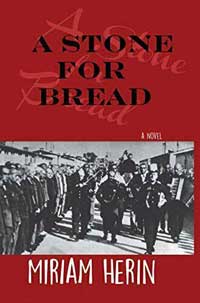Review by Kristina Moriconi, Change Seven Magazine, April 14, 2017
On the pages of A Stone for Bread, there are intersections where readers will want to pause, places where poetry and politics meet, where history and human relationships overlap and weave together, one shedding light on the continuity and complexity of the other.
Throughout Miriam Herin’s novel, readers will want to pause for other reasons as well: to listen to the lyrical sound of her language, to realize how easy it is to lose oneself in a story well-told, and to learn beyond the lessons of a classroom how one masters the craft of writing.
The first time I read A Stone for Bread, I read it fast, for content. In fact, I couldn’t put it down. I was drawn into the individual stories of each character, told in alternating chapters. And I was fascinated by the larger story of lives linked by love and loss, by the staggering, heart-stopping account of the Holocaust and the complicated, storied life of a poet named Henry Beam, Herin’s unforgettable main character. In this novel, the past loops and lingers, it ripples into the present to remind us and to cast shadow-making light on the deeds of both its champions and its monsters.
The second time I read this book, I slowed my pace intentionally. I read passages aloud. I marveled at the cadence of Herin’s poetic language in lines such as: “We’re the picnickers, the revelers, dancing on the bones of the dead.” And this: “When does an act of rebellion, he wondered, like one man alone against the tyranny of a tank, become an artistic act, a transcendent moment of truth?” I read certain lines more than once, paid close attention to the exquisite language of Herin’s metaphor: “…as if the dark angel released in him a fury of winged creatures that dug their teeth and talons into his soul.” And this: “Hope is a knife in the heart.”
I was aware as I read, in an awe-struck way, of the narrative threads Herin was braiding so beautifully and continuously throughout this novel. I mapped them in my mind and on paper: lives meticulously linked, stories stretching across centuries. As a reader, how I felt, without fail, in the hands of a trusted narrator. As a writer, how I studied closely both the specificity and the expansive scope of Herin’s storytelling.
A Stone for Bread is a novel I will keep close by. It is a book I will return to and one I will recommend to other writers and readers I know. In the now immortal words of Miriam Herin’s Henry Beam, “You have to…read it again, and again, until it breathes in you, flows through your bloodstream and beats in your heart.” And it will.

